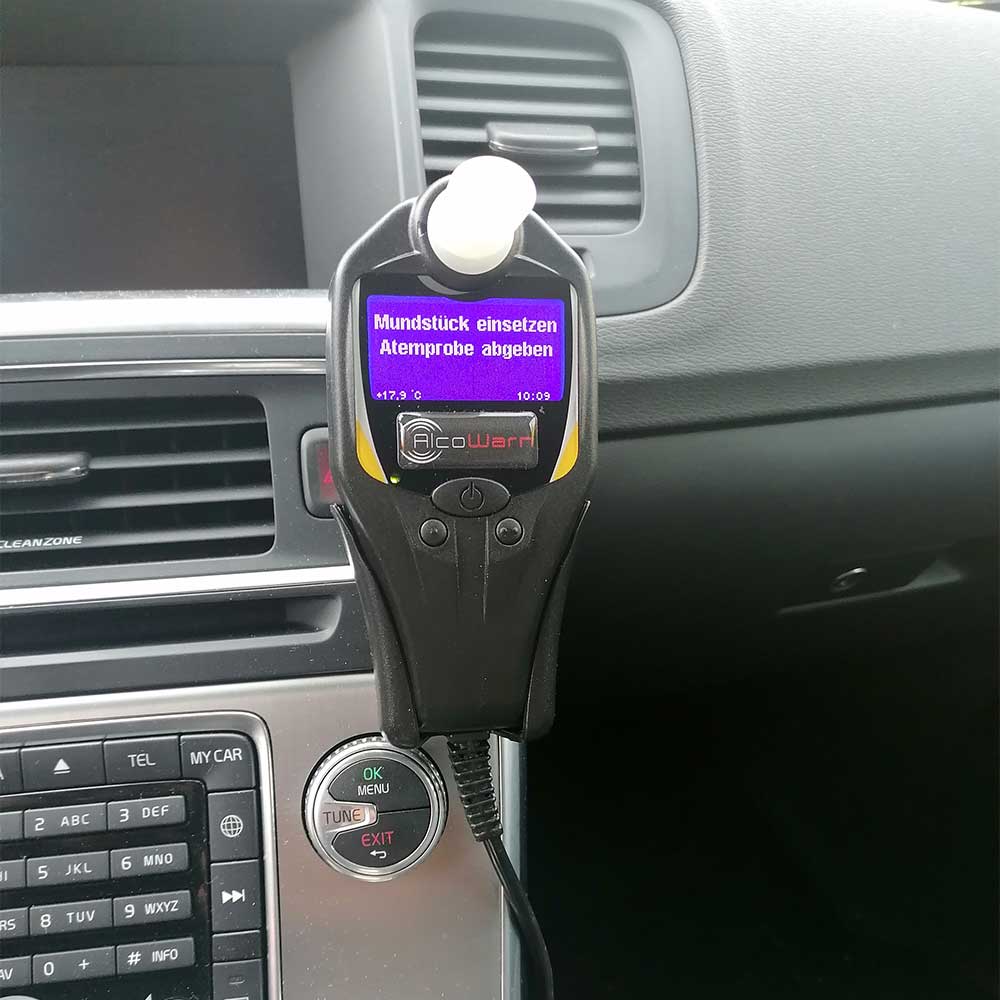AlcoWarn
Alkohol-Wegfahrsperre
Kein Alkohol im Straßenverkehr
Die Alkohol-Wegfahrsperre von AlcoWarn: Sicherheit durch Prävention
In Deutschland und vielen anderen Ländern ist die Problematik des Fahrens unter Alkoholeinfluss ein ernstes Thema. Jährlich kommt es zu zahlreichen Verkehrsunfällen, die durch Alkohol am Steuer verursacht werden. Um diesem Problem entgegenzuwirken und die Verkehrssicherheit zu erhöhen, wurden innovative Technologien entwickelt. Eine dieser Lösungen ist die Alkohol-Wegfahrsperre von AlcoWarn, auch bekannt als Alkohol-Interlock oder „breath alcohol ignition interlock device“ (BAIID).
PreLock 90, Die Alkohol-Wegfahrsperre von AlcoWarn
Die Alkohol-Wegfahrsperre besteht aus zwei Teilen: einem Handgerät mit Messanzeige und einem Steuergerät, das unter der Abdeckung des Armaturenbretts in Reichweite des Fahrersitzes eingebaut wird.

PreLock 90 von AlcoWarn
Der Fahrer betätigt zuerst die Zündung.
Dann erfolgt beispielsweise durch einen Signalton oder ein LED-Licht am Handgerät eine Aufforderung zur Abgabe einer Atemprobe.
Das Handgerät misst die Alkoholkonzentration im Atem und nach etwa fünf Sekunden wird das Ergebnis auf dem Display angezeigt
Die Alkohol-Wegfahrsperre von AlcoWarn überzeugt durch mehrere beeindruckende Merkmale.
Erstens basiert sie auf einer zuverlässigen und genauen Technologie, die in der Lage ist, den Alkoholgehalt in der Atemluft genau zu messen. Dadurch wird sichergestellt, dass Fahrer nicht unter Alkoholeinfluss fahren können.
Zweitens ist die Alkohol-Wegfahrsperre benutzerfreundlich. Sie ist einfach zu bedienen und verfügt über ein gut sichtbares Display mit klaren Anweisungen. So kann der Fahrer schnell erkennen, ob er fahrtüchtig ist oder nicht.
Darüber hinaus bietet AlcoWarn einen ausgezeichneten Kundendienst und Support. Bei Fragen oder Problemen steht das Team jederzeit zur Verfügung.
Zusammenfassend lässt sich sagen, dass sich die Wegfahrsperre von AlcoWarn durch Präzision, Benutzerfreundlichkeit und einen ausgezeichneten Kundendienst auszeichnet. Sie ist eine zuverlässige Lösung, um Alkohol am Steuer zu verhindern und damit die Straßen sicherer zu machen. Darüber hinaus ist die Wegfahrsperre sehr robust und langlebig. Sie wurde aus hochwertigen Materialien hergestellt, um den Anforderungen des täglichen Gebrauchs standzuhalten. So ist sichergestellt, dass sie auch bei schlechten Witterungsbedingungen oder anderen Herausforderungen zuverlässig funktioniert.
Ein weiterer Vorteil des Alkohol-Interlocks von AlcoWarn ist seine Flexibilität. Sie kann in verschiedene Fahrzeugtypen eingebaut werden und eignet sich sowohl für den privaten als auch für den gewerblichen Einsatz. Darüber hinaus bietet sie verschiedene Anpassungsmöglichkeiten, wie z.B. individuelle Einstellungen für den Blutalkoholgehalt oder spezielle Warnhinweise.
Nicht zuletzt trägt der Einsatz einer solchen Wegfahrsperre dazu bei, das Bewusstsein für das Thema “Alkohol am Steuer” zu schärfen und damit langfristig die Zahl der Verkehrsunfälle zu reduzieren.
Insgesamt überzeugt die Alkohol-Wegfahrsperre von AlcoWarn durch ihre hohe Qualität und ihren Nutzen für die Erhöhung der Verkehrssicherheit auf unseren Straßen. Durch ihre zuverlässige Funktion und Flexibilität ist sie eine sinnvolle Investition für jeden Fahrzeughalter, der Verantwortung im Straßenverkehr übernehmen möchte.
Der Einbau einer solchen Wegfahrsperre kann dazu beitragen, schwere Unfälle durch Alkohol am Steuer zu vermeiden und damit Menschenleben zu retten.
Mit dieser innovativen Technologie setzen wir von AlcoWarn ein Zeichen gegen Alkohol am Steuer und leisten einen wichtigen Beitrag zur Erhöhung der Verkehrssicherheit auf unseren Straßen.
Funktionsweise einer Alkohol-Wegfahrsperre
Der Nutzungsablauf ist relativ einfach:
- Der Fahrer dreht den Zündschlüssel zum Starten um.
- Die zwingende Abgabe eines Alkoholtests wird angezeigt.
- Der Fahrer gibt über ein (aus hygienischen Gründen austauschbares) Mundstück am Handgerät eine Atemprobe ab.
- Nach ca. 5 Sekunden erscheint das Ergebnis der Atemalkoholmessung auf dem Display des Handgerätes.
- Nur wenn die zuvor eingegebenen Grenzwerte nicht überschritten werden, wird die Zündung freigegeben.
- Einer alkoholfreien und damit sicheren Fahrt steht nichts mehr im Wege.
FAQ:
Rufen Sie an – Wir sind für Sie da.
+49 (0) 4822 3688 963
Oder senden Sie eine E-Mail
service@alcowarn.com
